New fossil finds show small pre-humans were living on an Indonesian island 700,000 years ago, researchers reported on Wednesday.
The findings support the idea that a race of slender, short hominins evolved in southeast Asia, probably from Homo erectus. And they are strong evidence against theories that bones of a tiny pre-human called the “Hobbit” that lived on the same island millennia later came from a deformed early human.

They add to an increasingly colorful picture of a world populated by a variety of pre-human species hundreds of thousands of years ago, and that our current world with just one species of humans is, in fact, unusual.
The evidence comes in the form of just a few teeth, a bit of skull and a fossilized jawbone dug up on the island of Flores by an international team of archeologists.
“Remarkably, these fossils, which include two milk teeth from children, are at least 700,000 years old,” said Gert van den Bergh of the University of Wollongong in Australia, who helped write the study published in the journal Nature.
The ‘Hobbit’, formally named Homo floresiensis, caused a stir when its discovery was announced in 2004. Only 50,000 to 100,000 years old, it represented a tiny, primitive type of pre-human never before imagined.
Some scientists wondered if the three-foot-high adult evolved separately. Some thought it might represent a patient with a birth defect such as Down’s syndrome. Still others thought it might be a case of a tiny sub-species evolving to fit in with conditions on a small island.

Researchers have been looking for more evidence since then. They found tools but didn’t find the teeth and bones until 2014. They report their discoveries in two separate papers in Nature.
“All the fossils are indisputably hominin and they appear to be remarkably similar to those of Homo floresiensis,” said Yousuke Kaifu of Tokyo’s National Museum of Nature and Science, who worked on the study.
“The morphology of the fossil teeth also suggests that this human lineage represents a dwarfed descendant of early Homo erectus that somehow got marooned on the island of Flores.”
The tiny jawbones and teeth show that the pre-humans living on the island were already very small a very long time ago.
“What is truly unexpected is that the size of the finds indicates that Homo floresiensis had already obtained its small size by at least 700,000 years ago,” Van den Bergh said.
Now the question is how they got there, how many lived on the island, and what killed them off 50,000 years ago – which is about the time modern humans got to the area.

